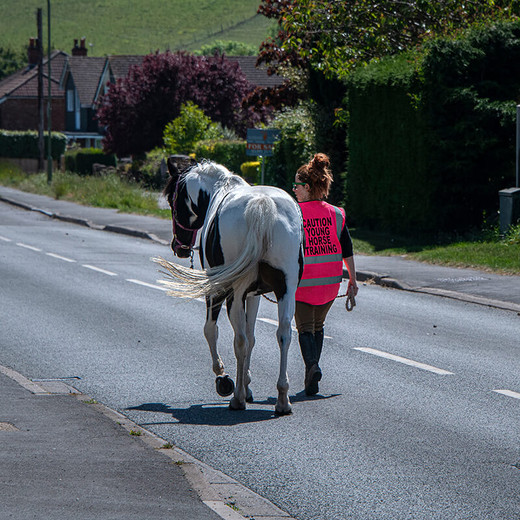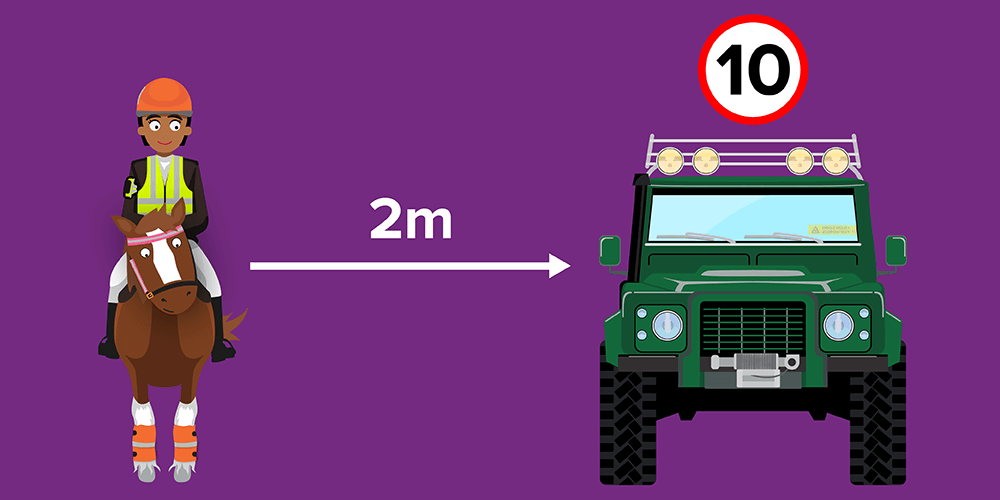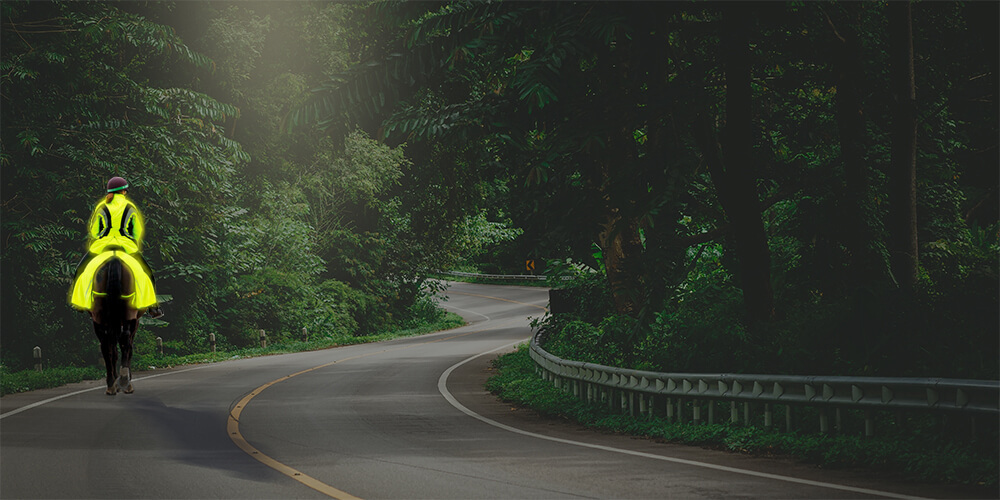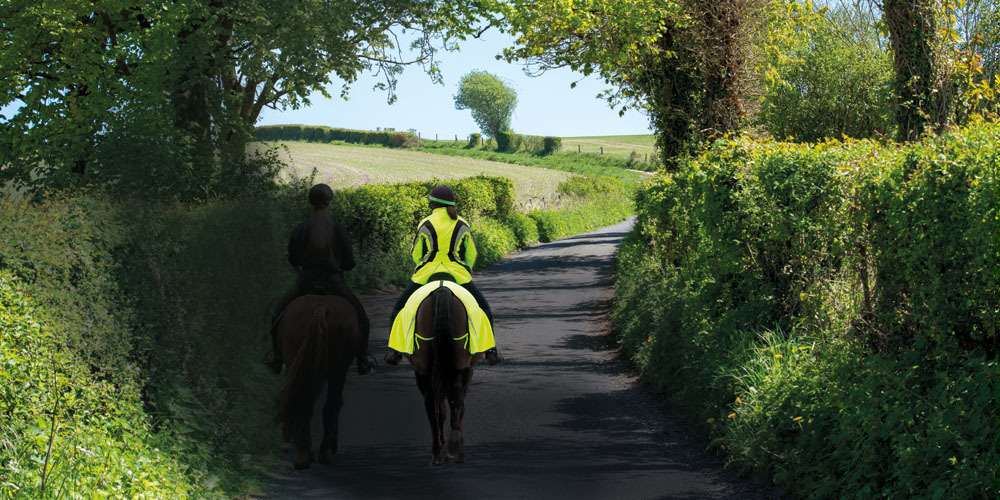How to be seen when horse riding
May 24th 2022

It is important that horse riders ensure they are visible both on the road, as well as out hacking in fields or forests. Where being visible on the road can help to prevent road accidents, ensuring your visible in greener areas allows you to not only be seen in your surroundings but also visible from a height. This can aid in search and rescue if an accident were to occur or for a pilot to adjust their flight path if necessary. The best way to be seen when horse riding is to wear hi-visibility clothing and equipment.
How to be seen when horse riding
It is always recommended you wear hi-visibility clothing when riding all the time. Regardless of whether you ride on or off the road, the time of day or weather conditions. Research shows that wearing hi-vis can give drivers an extra 3 second reaction time, which in turn can reduce the chance of an accident. To put this into context, if a car is travelling at 30mph, an increase in a 3 second reaction time gives the driver an extra 40m of stopping distance which is the length of a standard arena.

Recently there has been an update to the highway code rules which now focus on the hierarchy of road users, improving road safety for people walking, cycling and riding. Below are some of the key road rules for horse riders:
- Allow at least 2 meters of space when passing
- Slow down as you pass at a maximum speed of 10mph
- Horse riders and drivers of horse drawn vehicles likewise have a responsibility to reduce danger to pedestrians.
- Horse riders should also give way to pedestrians on a zebra crossing, and to pedestrians and cyclists on a parallel crossing.
There are also new rules which relate to shared space.
- When riding a horse or driving a horse-drawn vehicle should you respect the safety of people walking. However, people walking should also take care not to obstruct or endanger.
People cycling are asked to:
- Not pass a horse rider or horse-drawn vehicle closely or at high speed, particularly from behind.
- Not pass a horse on the horse’s left side.

How does high visibility fabric work?
High-visibility clothing is made from fluorescent material and reflective strips. When artificial light or the sun’s ultraviolet rays hits the fabric, it reacts to create a glowing appearance. The combination of reflective strips is to aid visibility in times of poor and low light conditions. Illuminated light sources, such as cars or torches will cause the strips to glow.
Fluorescent colours are used for hi-vis clothing because they react with the ultraviolet rays of the sun and appear to ‘glow’. They are exceptionally bright because of the way they absorb and emit light. This ‘glowing’ of fluorescent colours is particularly effective in low light conditions. For example under tree cover, dusk, dawn and in misty or foggy weather.

How to be seen in the dark?
Although fluorescent clothing is ideal in daylight and low light it does not ‘glow’ in the dark as is often believed. To be seen in the dark you must wear clothing with retro-reflective bands. Retro-reflective tape reflects light back to its source with minimum scattering. When car headlights hit the retro-reflective tape it is reflected back to the driver. Hi-vis items that meet the BETA safety standards will feature true retro-reflective bands and will do the job intended. Cheaper alternatives and items that do not carry the BETA safety standards. They may feature silver/grey strips of what looks like reflective material, but that does not mean they are retro-reflective. In fact they may offer no reflective properties at all!
Full retro-reflective clothing can be purchased, however it is worth noting that all over retro-reflective clothing is most effective at night. Therefore, we would not recommend this as alternative to hi-vis for daylight. If you are opposed to too much hi-visibility clothing you could pair this with it and will aid in you being more visible if cars have headlights on.
Wearing a rainbow of hi-vis
Hi-visibility clothing is available in variety of different colours to suit every taste. The most popular and traditional colour is yellow, however you can also purchase orange and pink. When selecting your hi-vis colours you should always take into consideration the time of year and your most common surroundings. The contrast of colours to a background can really impact whether you stand out or not. For example, if you regularly ride past fields of rapeseed, yellow will not stand out as well as pink. Orange may blend into autumn leaves of the trees and hedge rows. Meaning yellow or pink would be a better contrast in this instance.
How about choosing a mixed rainbow of colours? This may not be quite so easy on the eye but wearing a mix of the hi-vis colours will create an extremely eye-catching moving object, positively effecting your safety.

Highlight moving parts
Research has shown our brains have the uncanny ability to recognise other human beings, this is called ‘ sensitivity to biomotion’. An extremely good reason to why you should highlight your body’s moving parts. For example wearing a hat band when you ride can highlight the movement of your head or an arm band when signalling. This can also be applied to moving parts of your horse so hi-vis leg bands for their legs or a hi-vis tail band for their tail.
Shine bright with lights
Easily available now are a range of light up equestrian products, these include breastplates and tail sleeves. By wearing LED lights, you are increasing your visibility in the day. This is even more so during bad weather and dark conditions. The best practice is to wear white lights to the front and red lights to the rear. This indicates to drivers the direction in which you are travelling in.
Hi-visibility standards
With so many varieties of hi-vis clothing and accessories available, it is important you are giving yourself the best protection possible. To help riders buy hi-vis clothing in confidence, BETA and a hi-vis specialist collaborated to launch the BETA High Visibility Certification Scheme .
Hi-vis clothing for leisure riders should reach the standard EN1150. This level ensures that it has been tested and approved for use. However, if you wear hi-vis for work your clothing should hold standard EN471 & EN20471 as these meet health and safety legislation. Any hi-vis accessories should reach the standard EN13356.
How often should you replace your high-visibility clothing?
There is no set time to replace high-visibility safety clothing due to several varying factors. These include the number of wash cycles or any damage to the fabric it may have incurred. It is important to regularly clean/wash high-visibility gear as dirt can hinder its effectiveness. Make sure you follow washing instructions carefully to avoid damaging your products. After washing you hi-vis garments you should check it has retained its glowing qualities, it could save your life.
Time to reflect (excuse the pun!)

The above image is startling and really brings the reality of wearing hi-vis into context. There are no laws to say that horse riders must wear hi-vis clothing when riding. However, it is definitely in your best interests to.
We would love to hear your thoughts on this subject!




